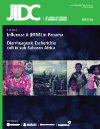Trends in antimicrobial susceptibility of Gram-negative bacteria isolated from blood in Jakarta from 2002 to 2008
DOI:
https://doi.org/10.3855/jidc.85Keywords:
Gram negative bacteria, susceptibility to antibioticsAbstract
Background: This study examined the susceptibility of Gram-negative bacteria in the bloodstream to antimicrobials with the aim of providing information relevant to the guidance of therapy.
Methodology: Blood specimens received by the Laboratory of Clinical Microbiology, Faculty of Medicine, University of Indonesia, from 2002 to 2008, were analyzed for the presence of Gram-negative bacteria and their susceptibility to four antibiotic groups frequently administered in hospitals and community settings.
Results: During the seven-year period leading up to 2008, approximately 68% of Gram-negative bacteria were identified among all positive isolates from blood specimens. The eight most frequent species found were Acinetobacter anitratus (25.8%), Pseudomonas aeruginosa (19.5%), Klebsiella pneumoniae subsp. pneumoniae (14.5%), Enterobacter aerogenes (8%), Salmonella Typhi (7.5%), Escherichia coli (6.2%), Alcaligenes faecalis (5.6%) and Klebsiella oxytoca (3.2%). At 80% susceptibility or greater, Ceftriaxone and Cefotaxime were active only on E. coli and S. Typhi. Cefepime demonstrated activity on all eight species tested except K. pneumonia while Amikacin showed activity against five species, A. faecalis, E. aerogenes, E. coli, K. pneumoniae subsp. pneumoniae and S. Typhi. Gentamycin was active against three species: E. aerogenes, K. oxytoca and S. Typhi. Ciprofloxacin and Levofloxacin significantly differed in their spectrum: while Ciprofloxacin was active against four of the eight species tested (E. aerogenes, E. coli, K. oxytoca, and S. Typhi ), Levofloxacin was similar to Cefepime and was active against all eight species except K. pneumoniae subsp. pneumonia.
Conclusions: Since antimicrobials are broadly used in Jakarta, it is important that the information captured in this study be disseminated.
Downloads
Published
How to Cite
Issue
Section
License
Authors who publish with this journal agree to the following terms:
- Authors retain copyright and grant the journal right of first publication with the work simultaneously licensed under a Creative Commons Attribution License that allows others to share the work with an acknowledgement of the work's authorship and initial publication in this journal.
- Authors are able to enter into separate, additional contractual arrangements for the non-exclusive distribution of the journal's published version of the work (e.g., post it to an institutional repository or publish it in a book), with an acknowledgement of its initial publication in this journal.
- Authors are permitted and encouraged to post their work online (e.g., in institutional repositories or on their website) prior to and during the submission process, as it can lead to productive exchanges, as well as earlier and greater citation of published work (See The Effect of Open Access).








